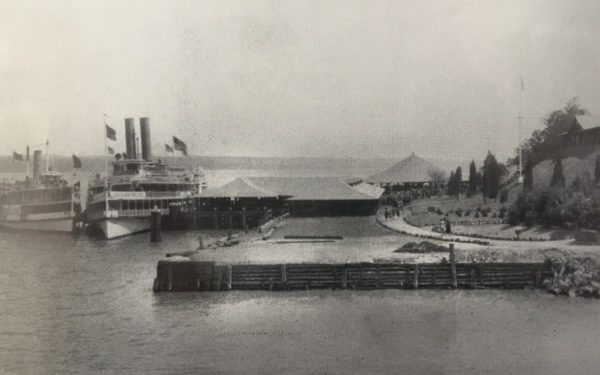by Mike Hays
If there was a Truth In Advertising Law for state parks, the beautiful public space on the Hudson River at the end of North Broadway would be called Nyack Beach-less State Park. If you have strolled or cycled the along the river from Nyack Beach State Park it’s hard to imagine that nearbytwas a park with tennis courts, baseball diamonds, a stone walled cafeteria, a small lighthouse, an amusement park with a carousel, bumper cars, a dance hall, and a large swimming beach too.

It was once a popular public beach, but today Hook Mountain Beach is mostly rocks.
Hook Mountain Beach bears almost no resemblance today to its former use. The area is overgrown but a few foundations and a few abandoned stone buildings reward a diligent search. Several plateaus that were once open above the beach are overgrown but one can easily imagine the shouts of families enjoying themselves on a hot summer day.

Early schematic of Hook Mountain Beach (PIPC)

The beach park was located at the end of the current riverside footpath from Nyack Beach at the 1-1/4 mile mark where it intersects with a paved road coming down from Rockland Lake; locals will know it as the place where the picnic tables are before the path starts a sharp climb up the mountain. A small point of land juts out into the river. Just north of this point you can find foundations and old pier posts in the river. Both the quarries and the Rockland Lake Ice Company used piers here to ship goods to New York City. There is a small warning light on a pile of rocks in the river that is still visible. It was once a small lighthouse. Because of the curve of the river around Hook Mountain, a river traveler sees neither Nyack nor Haverstraw from this point.
When did swimming in the Hudson stop being a thing?

Hook Mountain Beach in the mid-1930s looking south. Note the wading pool in the foreground and in the distance a beach with swimmers.
Industrial and population growth in the 1950s brought more river pollution of every kind. With mixed results, parents warned their kids out of the river, where they had been swimming forever — at the Hook, at the Bight, from backyards, parks, docks and rowboats. READ MORE about the sad history of lost swimming and fishing holes on the river at Swimming Lessons: on The Hudson River, part of the weekly Earth Matters series on Nyack News And Views.
The beach had a real amusement park complete with a bathhouse, a wading pool, a carousel, a hand-turned merry-go-round, swingsets, bumper cars, dance pavilion, and, of course beaches. The north and south beaches were segregated.
Car access was via a road that came down from the town of Rockland Lake. The town of Rockland Lake is mostly gone now along with the lake resorts near where 9W is today. Buildings were purchased and removed about the same time as the riverside beaches were created. A paved road, not open to the public, still heads down the hill at the same point.
There was a cafeteria/hotel above the beach. On level plateaus above the beach on either side of the cafeteria were tennis courts and baseball diamonds. Foundation stones of the cafeteria still exist slightly uphill. In the river, a pile of rocks can be seen off the point that once was the site of a small lighthouse.

The cafeteria/hotel at the top of the beach in 1925. Notice that the hillside above it is treeless from the quarrying operations.
Park access was predominately from NYC dayliners like the Clermont, Alexander Hamilton, Robert Fulton, Peter Stuyvesant, and the City of Keansburg. The beach park was closed in 1942 because of WWII and destroyed by a hurricane in the late 1940s never to return.

Dayliner steamships from NYC docked at the beach, mid 1920s. The carousel can be seen in the background.

The dance pavilion at Hook Mountain Beach in the 1940s.

Postcard with well-dressed walkers in the 1920s. Probably looking north toward Hook Mountain Beach.
See also:
- Nyack People & Places: When Nyack Beach Was A Beach, 7/12/2017
- Hook Mountain and Nyack Beach State Park, 2/2012 GoneHikin.blogspot.com
- Hook Mountain Beach oil painting by William Bruckner, WilliamBruckner.com
Michael Hays is a 30-year resident of the Nyacks. He grew up the son of a professor and nurse in Champaign, Illinois. He has recently retired from a long career in educational publishing with Prentice-Hall and McGraw-Hill.  He is an avid cyclist, amateur historian and photographer, gardener, and dog walker. He has enjoyed more years than he cares to count with his beautiful companion, Bernie Richey. You can follow him on Instagram as UpperNyackMike.
He is an avid cyclist, amateur historian and photographer, gardener, and dog walker. He has enjoyed more years than he cares to count with his beautiful companion, Bernie Richey. You can follow him on Instagram as UpperNyackMike.
Nyack People & Places features photos and profiles of citizens and scenes near Nyack, NY. Sponsored by Weld Realty.
Photo Credit: Mike Hays
Historical photos courtesy of the Nyack Library
Source: Nyack in the 20th Century, Nyack Historical Society, 2000








